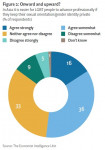Industrial commodity prices are expected to remain in the doldrums in 2009
Prices—especially for base metals—started to weaken in the second quarter 2008, but went into freefall in the second half of the year and particularly in the final quarter. Stocks are relatively low but this offered little price support, as market participants priced in a contraction in demand in 2009 amid signs that many OECD countries would be in recession and emerging market growth was set to slow significantly.
· Collapsing OECD property markets and consumer demand (with particularly negative consequences for the auto and consumer electronics sectors), has left base metal prices looking particularly vulnerable. However, prices also suffered as financial investors fled the market, selling commodity investments in order to cover losses elsewhere. Average base metal prices are thus expected to fall by 47% in 2009, with only a modest recovery, of 12% in 2010, assuming some nascent signs of recovery in demand and a continued low level of global stocks.
· Demand for natural rubber will also fall as a result of the downturn in the global automotive sector as well as the improvement in the price competitiveness of synthetic rubber (owing to lower international oil prices). In such a weak demand environment, the planned rubber cartel (operated by Malaysia, Indonesia and Thailand) is unlikely to be successful in supporting prices. The Economist Intelligence Unit has revised down its forecast of natural rubber prices in 2009 and now expects a fall of 44% in average prices.
· The Economist Intelligence Unit is moderately more bullish on the outlook for fibres. Reduced cotton plantings globally (as planting grain now appears more lucrative) will help contain the expected fall in price resulting from lower global demand. However, offsetting lower supply is the fact that the cost of manmade substitutes, such as acrylic and polyester (which use petroleum products in their manufacture), is falling.
· In 2010 we expect a limited rebound in the prices of most industrial raw materials. Although the global economy will remain weak, investors will start to become more optimistic about longer term prospects. Commodity stocks will be low, partly because of cutbacks to production enacted in 2009. Furthermore, investment in the raw materials industries will be at a low level, partly owing to a lack of available financing in late 2008 and in 2009, creating some concerns about future supply and the risk of shortages once demand starts to grow more strongly.
The IRM index accounts for about 44% of the Economist Intelligence Unit's world commodity forecasts (WCF) index, the remainder being accounted for by soft commodities. The prices of soft commodities are also expected to be weak in 2009 but they are not so closely linked to the business cycle and thus the WCF index is expected to fall by 32% in 2009.
Crude oil
We have revised down our forecast of crude oil prices (which are not included in the IRM index) in 2009 to an average of just US$35/barrel for Brent (US$37/b for WTI). Our crude oil price index (a weighted average of the major benchmark prices) is expected to fall by 64% in 2009 as a whole. A collapse in demand—we expect global demand to contract for the second consecutive year—is the principal factor underpinning the expected oil price weakness. While we do expect OPEC to be successful in withholding supply, led by Saudi Arabia; compliance with OPEC quotas is unlikely to be perfect as a number of major OPEC suppliers will be encountering fiscal constraints. We expect prices to trough in the first half of 2009, before starting to recover somewhat in the second half of the year on hopes of stronger demand in 2010 and lower oil stocks. Weak growth in non-OPEC supply, persistent geopolitical tensions in a number of key oil producers and low levels of investment in 2009 suggest that prices will move higher in 2010. However, the likely progressive relaxation of OPEC's production ceilings will mean that prices are only expected to average US$50/b for Brent in that year.
Short-term price risks, however, are on the upside, with an ever-present threat that geopolitical developments―in the Middle East, Africa and Latin America―will severely disrupt already-constrained oil supply. The ongoing financial turbulence also creates risks—both upside and downside—as investors struggle to find an asset class that could yield positive returns; suggesting that the price will remain volatile for much of 2009.
For specific commodities, the Economist Intelligence Unit’s current forecasts are as follows:
Overview: The demand outlook for industrial raw materials (IRM) has deteriorated further. The Economist Intelligence Unit's IRM index is now expected to fall by 41% in 2009 and to rise only modestly in 2010.
Aluminium: A sharp fall in demand will be matched by cuts in production, particularly in the US, China and parts of the EU. Stocks will fall in 2009, and by 2010 there will be a modest recovery in prices.
Copper: In the light of planned and likely cutbacks in production, the copper market will remain broadly in balance in 2009-10. However, with only subdued growth in demand, there will be little upward pressure on prices until late 2010.
Crude oil: Global demand for crude oil will contract in 2009 for the second consecutive year. Lower supply, owing to OPEC production restraint, will put a floor under prices. However, OPEC quota compliance will not be perfect and we expect only a modest rise in prices as demand starts to recover in 2010.
Fibres: The decline in global prices for cotton from end-2008 is likely to discourage plantings, which will lead to lower supply but will support some recovery in prices in 2010. In the wool industry, weaker demand for apparel and carpets in 2009-10 will mean that prices will remain depressed, despite lower production.
Lead: The lead market will record a small surplus in 2009, which is likely to lead to a stabilisation of prices at current low levels. Adequate supply in the market will mean that prices will rise only modestly as demand strengthens.
Natural rubber: As a result of much lower demand for tyres and other rubber manufactures, we have made substantial downward revisions to our price forecasts for 2009.
Nickel: Nickel stocks are currently high and any recovery in prices therefore depends on a recovery in demand. We expect the market to move closer to balance in mid-2010.
Tin: The market is in deficit, but this is unlikely to be sufficient to support a sustained recovery in prices as long as the economic outlook remains bearish. We expect further price weakness in the first half of this year.
Zinc: Despite a sharp fall in demand, production cutbacks will prevent significant oversupply in 2009 but will not be enough to lead to a price rally. Some recovery in prices is expected in 2010 on the back of stronger demand.
About the Economist Intelligence Unit
The Economist Intelligence Unit is the business information arm of The Economist Group, publisher of The Economist. Through our global network of more than 700 analysts and contributors, we continuously assess and forecast political, economic and business conditions in 200 countries. As the world's leading provider of country intelligence, we help executives make better business decisions by providing timely, reliable and impartial analysis on worldwide market trends and business strategies.
웹사이트: http://www.eiu.com
연락처
Joanne McKenna: +44 (0)20 7576 8188 or 이메일 보내기
이 보도자료는 Economist Intelligence Unit가(이) 작성해 뉴스와이어 서비스를 통해 배포한 뉴스입니다.




